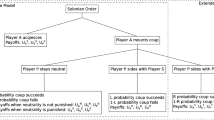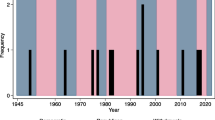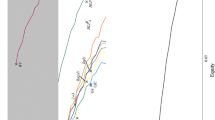Abstract
Whether international human rights treaties constrain the behavior of governments is a hotly contested issue that has drawn much scholarly attention. The possibility to derogate from some, but not all, of the rights enshrined in the International Covenant on Civil and Political Rights (ICCPR) during declared and officially notified states of emergency provides a hitherto unexplored test case. If governments were increasingly violating non-derogable rights during derogation periods then this provides evidence that the ICCPR has no sufficient constraining effect on state parties. I analyze whether specific individual human rights as well as two aggregate rights measures are systematically more violated during derogation periods in a global sample over the period 1981 to 2008. I find that regime type matters: autocracies step up violation of both non-derogable and derogable rights, anocracies increasingly violate some derogable and some non-derogable rights, whereas democracies see no statistically significant change in their human rights behavior during derogation periods. This result suggests that the main general international human rights treaty fails to achieve its objective of shielding certain rights from derogation where, as in autocracies and anocracies, a constraining effect would be needed most.
Similar content being viewed by others
Notes
A derogation is the complete or partial elimination of an international obligation (McGoldrick 2004: 383).
The Human Rights Committee to the ICCPR has criticized several states for failing to notify apparent declared or de facto states of emergency, some of which have subsequently officially derogated (Oraá 1992: 80).
The more extensive list of non-derogable rights under the ACHR includes rights such as the right to marry and to build a family and the right to a name, which are very unlikely to be affected by a state of emergency.
Moreover, as Fitzpatrick (1998: 376f.) points out, derogation notices to the ACHR are not officially published. Derogations to the ECHR are listed on its website at http://conventions.coe.int/Treaty/Commun/ListeDeclarations.asp?NT=005&CV=0&NA=&PO=999&CN=8&VL=1&CM=9&CL=ENG. There was only one instance of a derogation to the ECHR for country years relevant to my sample without a corresponding derogation to the ICCPR. In this instance Albania notified the withdrawal of a derogation to the ECHR without, however, mentioning when the derogation came into effect in the first place.
There is a related literature investigating the effect that explicit domestic constitutional provisions for, among others, emergency powers and restrictions on the exercise of such powers have on human rights (Davenport 1996; Keith 2002; Keith and Poe 2004). These studies are interesting in their own right, but do not address the specific question analyzed in this paper. Moreover, simply because a country’s constitution does not explicitly mention the government’s right to declare a state of emergency does not imply that they cannot officially declare such a state if they are party to the ICCPR.
Since only a minority of derogating governments provided information on which rights they derogated from, at this stage no attempt was made to distinguish among different types of derogation. I leave this to future research.
This applies to the following: Chile 11/03/1976 to 07/09/1986, Ecuador 30/11/1999 to 04/01/2000 and 17/08/2005 to 20/03/2006, Georgia 07/11/2007 to 31/12/2008 (end of sample period), Guatemala 28/08/2006 to 16/11/2006, Russian Federation (Soviet Union) 21/09/1988 to 01/11/1991, Sri Lanka 01/09/1989 to 31/12/2002, Uruguay 30/07/1979 to 31/12/2008 (end of sample period). Note that because the sample starts in 1981, Uruguay has no within-variation on the derogation variable.
To see this, imagine an estimation model of the form y = b1 x + b2 z + b3 xz, with x a continuous and, for simplicity’s sake, z the only conditioning dummy variable. The marginal effect of x on y is given by b1 for z = 0 and by (b1 + b3) for z = 1. Now consider instead an estimation model of the form y = b4 x (for z = 0) + b5 x (for z = 1) + b6 z. b4 is the same as b1, while b5 is the same as (b1 + b3). In the first model, the interaction effect is statistically significant if b3 is statistically significantly different from zero. In the second model, it is significant if b4 and b5 are statistically significantly different from each other.
The shares of democracies and anocracies are higher in-sample than globally because only countries which have ratified the ICCPR enter the sample and these countries are more likely to be state parties.
Note that many of these countries have no within-variation on the derogation variables and have thus no impact on the estimated coefficient of the main variables of interest – they do, of course, impact on the other estimated coefficients, however.
Hafner-Burton et al. (2011) also argue that judicial independence affects the derogation decision. I do not include this variable here as its inclusion leads to a significant loss of observations due to missing data. However, results are robust and available on request.
These are Ecuador in 2000, Georgia in 2007, Nepal in 2002, Sudan in 1989 and Serbia/Montenegro in 2003. Nepal and Sudan became autocracies, the other countries (marginally) slipped into the anocracy category.
http://www2.binghamton.edu/political-science/institutions-and-elections-project.html. Accessed 23 April 2012.
http://www.prsgroup.com. Accessed 23 April 2012.
PARCOMP and PARREG are extremely highly correlated with each other. All country years with the highest score on PARCOMP also carry the highest score on PARREG.
Davenport (2007c: 491) notes that the latter part of the argument is controversial.
Cingranelli and Richards (2010a) downgrade the US on Extrajudicial Killings from 2 to 1 from 2004 onwards, from 1 to 0 on Torture in 2005 and 2006 and from 2 to 1 on Disappearances in 2004.
References
Baetschmann, G., Staub, K. E., & Winkelmann, R. (2011). Consistent Estimation of the Fixed Effects Ordered Logit Model. Working Paper No. 4. University of Zurich: Department of Economics.
de Mesquita, B., Bruce, G. W., Downs, A. S., & Cherif, F. M. (2005). Thinking inside the box: a closer look at democracy and human rights. International Studies Quarterly, 49, 439–457.
Cingranelli, D. L., & Richards, D. L. (1999). Measuring the level, pattern, and sequence of government respect for physical integrity rights. International Studies Quarterly, 43, 407–417.
Cingranelli, D. L., & Richards, D. L. (2010a). Cingranelli and Richards human rights dataset. http://ciri.binghamton.edu/.
Cingranelli, D. L., & Richards, D. L. (2010b). The Cingranelli and Richards (CIRI) human rights data project. Human Rights Quarterly, 32(2), 401–424.
Cole, D. D. (2003). Judging the next emergency: judicial review and individual rights in times of crisis. Michigan Law Review, 101(8), 2565–2595.
Davenport, C. A. (1996). ‘Constitutional Promises’ and repressive reality: a cross-national time-series investigation of why political and civil liberties are suppressed. Journal of Politics, 58(3), 627–654.
Davenport, C. A. (2004). The promise of democratic pacification: an empirical assessment. International Studies Quarterly, 48, 539–560.
Davenport, C. A. (2007a). State repression and political order. Annual Review of Political Science, 10, 1–23.
Davenport, C. A. (2007b). State repression and the domestic democratic peace. Cambridge: Cambridge University Press.
Davenport, C. A. (2007c). State repression and the tyrannical peace. Journal of Peace Research, 44(4), 485–504.
Davenport, C. A., & Armstrong, D. A., II. (2004). Democracy and the violation of human rights: a statistical analysis from 1976 to 1996. American Journal of Political Science, 48(3), 538–554.
Fein, H. (1995). More murder in the middle: life-integrity violations and democracy in the world, 1987. Human Rights Quarterly, 17, 170–191.
Ferrer-i-Carbonell, A., & Frijters, P. (2004). How important is methodology for the estimates of the determinants of happiness? Economic Journal, 114(497), 641–659.
Fitzpatrick, J. (1998). States of emergency in the Inter-American human rights system. In D. J. Harris & S. Livingstone (Eds.), The Inter-American system of human rights (pp. 371–394). New York: Oxford University Press.
Gilligan, M. J., & Nesbitt, N. H. (2009). Do norms reduce torture? Journal of Legal Studies, 38(2), 445–470.
Gleditsch, N. P., Wallensteen, P., Eriksson, M., Sollenberg, M., & Strand, H. (2002). Armed conflict 1946–2001: a new dataset. Journal of Peace Research, 39, 615–37.
Goldsmith, J. L., & Posner, E. (2005). The limits of international law. New York: Oxford University Press.
Hafner-Burton, E. M. (2008). Sticks and stones: naming and shaming the human rights enforcement problem. International Organization, 62(4), 689–716.
Hafner-Burton, E. M., & Tsutsui, K. (2007). Justice lost! The failure of international human rights law to matter where needed most. Journal of Peace Research, 44(4), 407–425.
Hafner-Burton, E., Helfer, L. R., & Fariss, C. J. (2011). Emergency and escape: explaining derogations from human rights treaties. International Organization, 65(4), 673–707.
Hartman, J. F. (1981). Derogation from human rights treaties in public emergencies. Harvard International Law Journal, 22(1), 1–52.
Hathaway, O. (2002). Do human rights treaties make a difference? Yale Law Journal, 111, 1935–2042.
Hill, D. W., Jr. (2010). Estimating the effects of human rights treaties on state behavior. Journal of Politics, 72(4), 1161–1174.
Hollyer, J. R., & Rosendorff, B. P. (2011). Why do authoritarian regimes sign the convention against torture? Signaling, domestic politics and non-compliance. Quarterly Journal of Political Science, 6(3–4), 275–327.
Iyer, V. (1999). States of emergency—moderating their effects on human rights. Dalhousie Law Journal, 22(2), 125–189.
Joseph, S., Schultz, J., & Castan, M. (2000). The international covenant on civil and political rights: Cases, materials, and commentary. New York: Oxford University Press.
Joseph, S., Schultz, J., & Castan, M. (2004). The international covenant on civil and polical rights: Cases, materials and commentary (2nd edition). Oxford: Oxford University Press
Keck, M. E., & Sikkink, K. (1999). Activists beyond borders—advocacy networks in international politics. Ithaca: Cornell University Press.
Keith, L. C. (1999). The United Nations international covenant on civil and political rights: does it make a difference in human rights behavior? Journal of Peace Research, 36(1), 95–118.
Keith, L. C. (2002). Constitutional provisions for individual human rights (1977–1996): are they more than mere ‘Window Dessing?’. Political Research Quarterly, 55(1), 111–143.
Keith, L. C., & Poe, S. C. (2004). Are constitutional state of emergency clauses effective? An empirical exploration. Human Rights Quarterly, 26, 1071–1097.
Lebovic, J. H., & Voeten, E. (2006). The politics of shame: the condemnation of country human rights practices in the UNCHR. International Studies Quarterly, 50, 861–888.
Marshall, M. G., Jaggers, K., & Gurr, T. R. (2010). Polity IV project. University of Maryland.
McCormick, J. M., & Mitchell, N. J. (1997). Human rights violations, umbrella concepts, and empirical analysis. World Politics, 49(4), 510–525.
McGoldrick, D. (2004). The interface between public emergency powers and international law. International Journal of Constitutional Law, 2(2), 380–430.
Morrow, J. D. (2007). When do states follow the laws of war? American Political Science Review, 101, 559–572.
Neumayer, E. (2005). Do international human rights treaties improve respect for human rights? Journal of Conflict Resolution, 49(6), 925–953.
Neumayer, E. (2007). Qualified ratification: explaining reservations to international human rights treaties. Journal of Legal Studies, 36(2), 397–430.
Oraá, J. (1992). Human rights in states of emergency in international law. Oxford: Clarendon.
Poe, S. C. (2004). The decision to repress: An integrative theoretical approach to the research on human rights and repression. In S. C. Carey & S. C. Poe (Eds.), Understanding human rights violations (pp. 16–38). Aldershot: Ashgate.
Powell, E. J., & Staton, J. K. (2009). Domestic judicial institutions and human rights treaty violation. International Studies Quarterly, 53(1), 149–174.
Regan, P. M., & Henderson, E. A. (2002). Democracy, threats and political repression in developing countries: are democracies internally less violent? Third World Quarterly, 23(1), 119–136.
Richards, D. L., & Clay, K. C. (2010). States of emergency and respect for peremptory norms. Research Paper 7. University of Connecticut: Human Rights Institute.
Riedl, M., & Geishecker, I. (2011). Ordered response models and non-random personality trails: Monte Carlo simulations and a practical guide. Discussion Paper 116. University of Göttingen: Centre for European, Governance and Economic Development Research.
Roy Chowdhury, S. (1989). Rule of law in a state of emergency. London: Pinter.
Simmons, B. A. (2009). Mobilizing for human rights—international law in domestic politics. Cambridge: Cambridge University Press.
Stata. (2003). Fixed effects ordered probit regression. College Station: Stata Corporation. http://www.stata.com/statalist/archive/2003-09/msg00103.html
University of Minnesota. (2012) Human rights in the administration of justice. University of Minnesota Human Rights Library. http://www1.umn.edu/humanrts/
Wiik, R. (2002). Democratisation in the name of civil society: A quantitative analysis of the impact of nongovernment organisations on democratisation. Norwegian University of Science and Technology. http://www.sv.ntnu.no/iss/Robert.Wiik/thesis.pdf.
Wood, R. M., & Gibney, M. (2010). The Political Terror Scale (PTS): a re-introduction and a comparison to CIRI. Human Rights Quarterly, 32(2), 367–400.
World Bank. (2010). World development indicators online. http://data.worldbank.org/data-catalog
Acknowledgement
I thank J. Lawrence Broz, Julia Gray, participants at the Political Economy of International Organizations Conference at Villanova University and the research seminar of the Department of Political Science at University College London, anonymous referees and the editor for many helpful comments.
Author information
Authors and Affiliations
Corresponding author
Rights and permissions
About this article
Cite this article
Neumayer, E. Do governments mean business when they derogate? Human rights violations during notified states of emergency. Rev Int Organ 8, 1–31 (2013). https://doi.org/10.1007/s11558-012-9144-y
Published:
Issue Date:
DOI: https://doi.org/10.1007/s11558-012-9144-y




